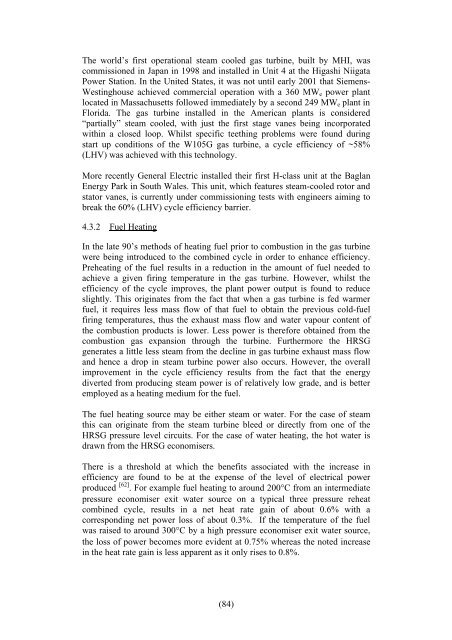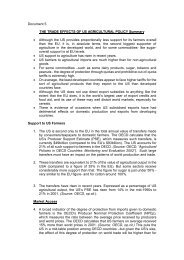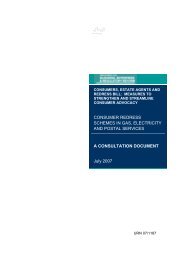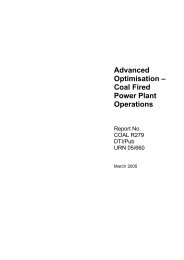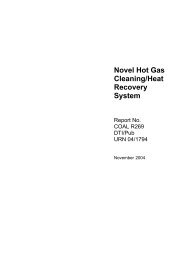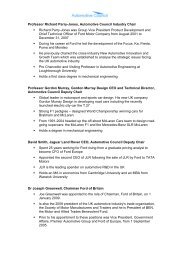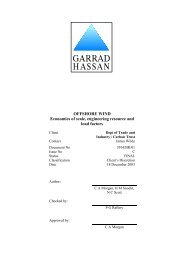(70) Therefore, the risk of sulphuric acid dew point attack ... - DTI Home
(70) Therefore, the risk of sulphuric acid dew point attack ... - DTI Home
(70) Therefore, the risk of sulphuric acid dew point attack ... - DTI Home
You also want an ePaper? Increase the reach of your titles
YUMPU automatically turns print PDFs into web optimized ePapers that Google loves.
The world’s first operational steam cooled gas turbine, built by MHI, was<br />
commissioned in Japan in 1998 and installed in Unit 4 at <strong>the</strong> Higashi Niigata<br />
Power Station. In <strong>the</strong> United States, it was not until early 2001 that Siemens-<br />
Westinghouse achieved commercial operation with a 360 MWe power plant<br />
located in Massachusetts followed immediately by a second 249 MWe plant in<br />
Florida. The gas turbine installed in <strong>the</strong> American plants is considered<br />
“partially” steam cooled, with just <strong>the</strong> first stage vanes being incorporated<br />
within a closed loop. Whilst specific teething problems were found during<br />
start up conditions <strong>of</strong> <strong>the</strong> W105G gas turbine, a cycle efficiency <strong>of</strong> ~58%<br />
(LHV) was achieved with this technology.<br />
More recently General Electric installed <strong>the</strong>ir first H-class unit at <strong>the</strong> Baglan<br />
Energy Park in South Wales. This unit, which features steam-cooled rotor and<br />
stator vanes, is currently under commissioning tests with engineers aiming to<br />
break <strong>the</strong> 60% (LHV) cycle efficiency barrier.<br />
4.3.2 Fuel Heating<br />
In <strong>the</strong> late 90’s methods <strong>of</strong> heating fuel prior to combustion in <strong>the</strong> gas turbine<br />
were being introduced to <strong>the</strong> combined cycle in order to enhance efficiency.<br />
Preheating <strong>of</strong> <strong>the</strong> fuel results in a reduction in <strong>the</strong> amount <strong>of</strong> fuel needed to<br />
achieve a given firing temperature in <strong>the</strong> gas turbine. However, whilst <strong>the</strong><br />
efficiency <strong>of</strong> <strong>the</strong> cycle improves, <strong>the</strong> plant power output is found to reduce<br />
slightly. This originates from <strong>the</strong> fact that when a gas turbine is fed warmer<br />
fuel, it requires less mass flow <strong>of</strong> that fuel to obtain <strong>the</strong> previous cold-fuel<br />
firing temperatures, thus <strong>the</strong> exhaust mass flow and water vapour content <strong>of</strong><br />
<strong>the</strong> combustion products is lower. Less power is <strong>the</strong>refore obtained from <strong>the</strong><br />
combustion gas expansion through <strong>the</strong> turbine. Fur<strong>the</strong>rmore <strong>the</strong> HRSG<br />
generates a little less steam from <strong>the</strong> decline in gas turbine exhaust mass flow<br />
and hence a drop in steam turbine power also occurs. However, <strong>the</strong> overall<br />
improvement in <strong>the</strong> cycle efficiency results from <strong>the</strong> fact that <strong>the</strong> energy<br />
diverted from producing steam power is <strong>of</strong> relatively low grade, and is better<br />
employed as a heating medium for <strong>the</strong> fuel.<br />
The fuel heating source may be ei<strong>the</strong>r steam or water. For <strong>the</strong> case <strong>of</strong> steam<br />
this can originate from <strong>the</strong> steam turbine bleed or directly from one <strong>of</strong> <strong>the</strong><br />
HRSG pressure level circuits. For <strong>the</strong> case <strong>of</strong> water heating, <strong>the</strong> hot water is<br />
drawn from <strong>the</strong> HRSG economisers.<br />
There is a threshold at which <strong>the</strong> benefits associated with <strong>the</strong> increase in<br />
efficiency are found to be at <strong>the</strong> expense <strong>of</strong> <strong>the</strong> level <strong>of</strong> electrical power<br />
produced [62] . For example fuel heating to around 200°C from an intermediate<br />
pressure economiser exit water source on a typical three pressure reheat<br />
combined cycle, results in a net heat rate gain <strong>of</strong> about 0.6% with a<br />
corresponding net power loss <strong>of</strong> about 0.3%. If <strong>the</strong> temperature <strong>of</strong> <strong>the</strong> fuel<br />
was raised to around 300°C by a high pressure economiser exit water source,<br />
<strong>the</strong> loss <strong>of</strong> power becomes more evident at 0.75% whereas <strong>the</strong> noted increase<br />
in <strong>the</strong> heat rate gain is less apparent as it only rises to 0.8%.<br />
(84)


